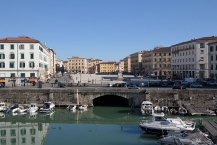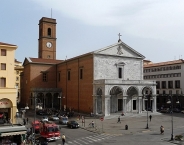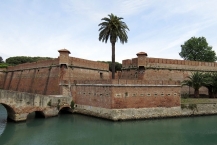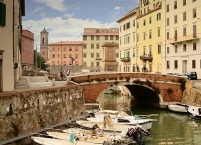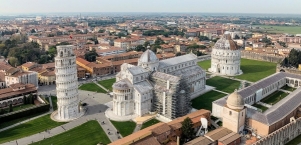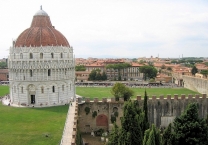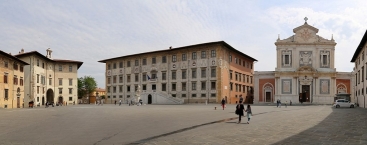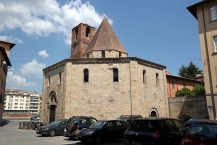Cycle Route Ciclovia Tirrenica
Actions
![]()
Please wait - map data are loading
Added on 04 Dec 2014,
last edited by biroto-Redaktion on 17 Sep 2023
Actions
Cycle route metrics
Total distance in km
599
Information about rights to the gps-track data | |
|---|---|
Rights owner | |
Rights characteristic / license | cc0: Public Domain no Rights reserved |
Link to the description of the license | |
GPX file uploaded | by biroto-Redaktion on 17 Sep 2023
|
Track points in total
9.004
Track points per km (avg)
15
Start/endpoint
Start location
Manciano, 52, IT (87 m NHN)
End location
Verona, 34, IT (64 m NHN)
Beds4Cyclists, worth visiting and infrastructure
Name and address
Latitude / Longitude
Phone
Fax
Mobile
Type of accommodation
Rating for cyclists
Route km
Dist. to route
Elevation
240 km
0,2 km
19 m
Information about copyright | |
|---|---|
Rights owner | |
Rights characteristic / license | by-sa: CREATIVE COMMONS Attribution-ShareAlike |
Link to the description of the license | |
Image taken over from | https://commons.wikimedia.org/wiki/File:Piazza_della_Repubblica_dalla_Fortezza_Nuova_(Livorno).JPG |
Image has been uploaded | by biroto-Redaktion on 14 Oct 2022
|
Information about copyright | |
|---|---|
Rights owner | |
Rights characteristic / license | by-sa: CREATIVE COMMONS Attribution-ShareAlike |
Link to the description of the license | |
Image taken over from | |
Image has been uploaded | by biroto-Redaktion on 14 Oct 2022
|
Information about copyright | |
|---|---|
Rights owner | |
Rights characteristic / license | by-sa: CREATIVE COMMONS Attribution-ShareAlike |
Link to the description of the license | |
Image taken over from | https://commons.wikimedia.org/wiki/File:Fortezza_Nuova_seen_from_via_degli_Avvalorati,_Livorno.jpg |
Image has been uploaded | by biroto-Redaktion on 14 Oct 2022
|
Information about copyright | |
|---|---|
Rights owner | |
Rights characteristic / license | by-sa: CREATIVE COMMONS Attribution-ShareAlike |
Link to the description of the license | |
Image taken over from | https://commons.wikimedia.org/wiki/File:Livornoveneziavecchia0001.jpg |
Image has been uploaded | by biroto-Redaktion on 14 Oct 2022
|
Livorno is a main port town in Tuscany. It was traditionally called Leghorn in English, nowadays the name is used to refer to a breed of chickens which were exported to North America from the Livorno port.
Understand
Livorno is on the Tyrrhenian sea in Italy. It is the third-largest port on the western coast. Upper Class travellers heading to Rome in the days of the Grand Tour ![]() would often go by sea to "Leghorn" from Marseilles or Genoa. This explains in large part the presence of a substantial English cemetery in the town.
would often go by sea to "Leghorn" from Marseilles or Genoa. This explains in large part the presence of a substantial English cemetery in the town.
See
During the Second World War, Livorno lost a large part of its historic building structure, but the city complex built under the Medici is still clearly visible. The old town is enclosed by the Fosso Reale moat and divided by the arcaded main shopping street Via Grande. The Venezia Nuova district, laid out in 1629, has many old buildings (including former warehouses) and is criss-crossed by canals reminiscent of Venice. Furthermore, buildings from the Belle Epoque have been preserved, especially villas on the Viale Italia waterfront in the southern districts of Ardenza and Antignano.
- ⊙Duomo Duomo San Francesco di Assisi
Dedicated to San Francesco, it was begun at the end of the sixteenth century on a project by Alessandro Pieroni. Later it was enlarged with the addition of two side chapels. Worthy of note is the valuable carved wooden ceiling, which was lost during the last world war, following the almost total destruction of the church. - ⊙Chiesa di San Giovanni Battista
Built in 1624 by Gianfranceso Cantagallina on an earlier building from the 13th century. - ⊙Chiesa di Santa Caterina
Begun in 1720 on a project by Giovanni del Fantasia, it was consecrated in 1755. With an octagonal plan, the church is characterized by a large dome, 63 meters high and reduced to the appearance of a tower due to problems of a static nature. Inside you can admire a remarkable oil painting by Vasari. - ⊙Chiesa della Madonna del Soccorso, Votive church built in the 19th century.
- ⊙Chiesa di San Jacopo in Acquaviva
Of millenary origins, until the sixteenth century the hermitage of San Jacopo was entrusted to the Augustinian Fathers. In the sixteenth century the complex was ceded to the community of the United Greeks and then returned to the Augustinians. Deeply modified in the second half of the eighteenth century, the current appearance dates back to the end of the nineteenth century. - ⊙Fortezza Vecchia
In this fortress all the centuries of the city's history overlap, starting from the first Roman settlements, up to the war devastation of the twentieth century. The current appearance is however due to Antonio da Sangallo the Elder, who, in the early sixteenth century, had the task of transforming a fortification of Pisan origin into an imposing war machine. - ⊙Fortezza Nuova New Fortress. Built by the Medici family to provide additional protection for the city to that provided by an older fortress closer to the sea. Good views of the canals from on top of the fortress but little to see in the fortress itself as much was destroyed in WW2.
- ⊙Palazzo Comunale
- ⊙Torre del Marzocco, octagonal tower near the port, built by the Florentines in 1439 as a sign of their new power.
- ⊙Teatro Goldoni, municipal Theater (1843–1847).
- ⊙Palazzo Gherardesca
- ⊙Monumento dei Quattro Mori
- ⊙Museo Provinciale di Storia Naturale del Mediterraneo, natural history museum with botanical garden.
- ⊙Museo Civico G. Fattori, the museum in Villa Mimbelli (1865) houses an important art collection with works by Macchiaioli.
- ⊙Acquario Comunale Diacinto Cestoni, sea aquarium.
- ⊙Piazza della Repubblica
- ⊙Old English Cemetery (Oldest in Italy, open on reservation). For info call Misericordia ☎ +39 0586 897324 or write an email to Association Livorno delle Nazioni.
- ⊙Venice Quarter. This is a small area of canals between the city and the sea, hence its name. Very pleasant to wander around.
Information about copyright | |
|---|---|
Rights characteristic / license | by-sa: CREATIVE COMMONS Attribution-ShareAlike |
Link to the description of the license | |
Input taken over from: |
|
taken over / edited on | 14 Oct 2022
|
taken over / edited by |
|
270 km
1,6 km
8 m
270 km
0,0 km
10 m
Information about copyright | |
|---|---|
Rights owner | |
Rights characteristic / license | by-sa: CREATIVE COMMONS Attribution-ShareAlike |
Link to the description of the license | |
Image taken over from | https://commons.wikimedia.org/wiki/File:Italy_-_Pisa_-_Cathedral_Square.jpg |
Image has been uploaded | by biroto-Redaktion on 14 Oct 2022
|
Information about copyright | |
|---|---|
Rights owner | |
Rights characteristic / license | by-sa: CREATIVE COMMONS Attribution-ShareAlike |
Link to the description of the license | |
Image taken over from | https://commons.wikimedia.org/wiki/File:Baptisterium_Pisa_IMG_5299.JPG |
Image has been uploaded | by biroto-Redaktion on 14 Oct 2022
|
Information about copyright | |
|---|---|
Rights owner | |
Rights characteristic / license | by: CREATIVE COMMONS Attribution |
Link to the description of the license | |
Image taken over from | https://commons.wikimedia.org/wiki/File:Pisa,_palazzo_della_carovana_00_piazza_dei_cavalieri.jpg |
Image has been uploaded | by biroto-Redaktion on 14 Oct 2022
|
Information about copyright | |
|---|---|
Rights owner | |
Rights characteristic / license | by-sa: CREATIVE COMMONS Attribution-ShareAlike |
Link to the description of the license | |
Image taken over from | https://commons.wikimedia.org/wiki/File:Pisa_-_Chiesa_del_Santo_Sepolcro,_01.JPG |
Image has been uploaded | by biroto-Redaktion on 14 Oct 2022
|
Pisa is a city in Tuscany , Italy , best known for its world-famous leaning tower. But the tower isn't the only thing to see – there are other architectural and artistic marvels in this beautiful city. The half-hour walk from the Campo dei Miracoli to the train station runs through a pedestrian street with many interesting sights, shops, and restaurants. The best way to visit Pisa is walking the streets, as the city centre is small and cosy, and enjoying the sight and the atmosphere.
Understand
Pisa would not be Pisa without the university. The city is animated by the students, who organize parties, shows, and cultural events, and fill the central street of the city at night. The University of Pisa has 60,000 students in a city of 90,000 inhabitants (200,000 in the metropolitan area). You'll notice the student flair in the city once you leave the touristy Campo dei Miracoli.
See
The Campo dei Miracoli from above: The leaning tower is on the left, the Duomo is in the centre, the Baptistery is on the right, and part of the Camposanto is in the right foreground
Pisa is divided into 4 historical quarters. There is much more than the leaning tower in the city and several different walking itineraries are available.
Piazza dei Miracoli
The Piazza dei Miracoli or Field of Miracles is to the North of central Pisa. It is an UNESCO World Heritage site and contains the city's most famous sights:
- ⊙Torre Pendente (Leaning Tower), Piazza Arcivescovado 1, ☎ +39 5083 5011.Daily 09:00-19:00.
The structure was conceived as the cathedral's bell tower. Construction began in 1173 and the tower started leaning soon afterwards due to subsidence of the ground underneath its base. A project to keep the tower from leaning more and tipping over finally reached a successful conclusion in 2001, and the tower is again open to those wishing to climb it.
Climbing the tower requires a reservation-based ticket for €18. Tickets can be bought for the tower on the day, for a specific entry time. This could be 45 min-2 hr after the purchase time, but there is a lot to see while you wait. It is better if you buy tickets online for €18 well in advance (up to 20 days). The tickets are non-exchangeable, effectively non-refundable, and only good for the tower, so they're a bit of a risk to purchase in advance. Make the effort to climb, though, and you'll be rewarded by the view. For safety reasons, children who will not have turned 8 by the end of the year are not permitted to enter. Under-18s must be accompanied by an adult. ID may be requested to certify the age. €18.
The famous Pisa leaning tower is not the only one in Pisa; due of the marshy land that they are built on, there are two other leaning towers in Pisa: the Bell Tower of ⊙San Nicola Church, near the banks of Arno and the Bell Tower of ⊙San Michele of Scalzi Church
. (updated Aug 2019)
- ⊙Duomo di Pisa (Pisa Cathedral). Daily, 10:00-19:00.
A splendid cathedral, containing artwork by Giambologna, Della Robbia, and other major artists. Fine Romanesque style with double aisles and a cupola, a huge apse mosaic partly by Cimabue, and a fine pulpit by Giovanni Pisano in late Gothic/early Renaissance style.
Free (but entry passes, up to 2 per person, must be obtained beforehand in a nearby ticket office).(updated Aug 2018)
- ⊙Battistero di San Giovanni (Baptistry of St. John). Daily, 9:00-19:00.
Large round Romanesque dome with many sculptured decorations and a fine view up top; climb this if you want a great view with the Leaning Tower visible in your photos. Arabic-style pavement, pulpit by Nicola Pisano (father of Giovanni), and fine octagonal font. At regular intervals, the ticket-checker-guard at the entrance comes into the baptistery and gives an audio-treat of echo-effect. The guard shouts out few sounds which when echoed sound like pure beautiful music. You can also cast your inhibitions to the wind, stand by the wall, and sing long notes that turn into chords by yourself, as the echoes go round and round the dome of the building.
Single ticket €5. A combined ticket with two museums is €7 and three museums is €8. It can be combined with the Monumental Cemetery and the Sinopie Museum.(updated Aug 2019)
- ⊙Camposanto Monumentale (Monumental Cemetery). Daily, 9:00-19:00.
A huge cemetery building with lots of interesting art, including a collection of ancient Roman sarcophagi and splendid medieval frescoes by the "Master of the Triumph of Death". There is also a 19th-century statue of the famous mathematician Leonardo Fibonacci, a native of the city.
Single ticket €5. A combined ticket with two museums is €7 and three museums is €8. It can be combined with the Baptistery and the Sinopie Museum. Free entrance to the cemetery on 1 and 2 Nov.(updated Aug 2019)
- ⊙Museo dell'Opera del Duomo. Daily, 9:00-19:00.
Has sculptures and paintings that used to be preserved in the Cathedral and the cemetery. Some of the more unusual are bronze griffins from Syria captured by the Crusaders. You can also capture nice photos from the Tower and the Duomo from its balcony. (updated Aug 2019) - ⊙Museo delle Sinopie. Closed for maintenance as of March 2020.
Skipped over by many visitors, this museum is a treat for art lovers. After World War II many of the surviving murals and pieces of murals from Pisa's Campo Santo were detached from the walls to try to preserve them. It was unexpectedly discovered that the artist sketches underneath survived. These were moved to this museum.
Single ticket €5. A combined ticket with two museums is €7 and three museums is €8. It can be combined with the Baptistery and the Monumental Cemetery. (updated Aug 2019) - A 3 km (1.9 mi) walking tour along the city walls is one of the newest attractions in the city. It is an occasion to see the city, including the leaning tower and Campo dei Miracoli, from an unusual angle. They offer a great view over public and private buildings around the city, as well as many unexpected green areas.
There are four entrances: one in Campo dei Miracoli (Torre Santa Maria), one next to a university campus near via Filippo Buonarroti (Torre Piezometric), one in Piazza delle Gondole, and one in Piazza del Rosso (Torre di Legno), hidden behind a tiny gate. Bring water and sunscreen on sunny days, since there is not the tiniest bit of shadow along the whole tour.
Open every day, 09:00-19:00 in the summer season. Tickets cost €3 (May 2019).
Piazza dei Cavalieri
⊙Piazza dei Cavalieri. A small town square with many historical buildings that hosted the political powers of the city in the Middle Ages and Renaissance, but most of them are not accessible to tourists, as they are now property of the University of Pisa or Scuola Normale Superiore (a prestigious elite school).
- ⊙Palazzo della Carovana. The main Scuola Normale Superiore building, with an elaborate façade, by the important Italian Renaissance artist and architect Giorgio Vasari - who is also said to be the first historian of art.
- ⊙Palazzo dell'Orologio (Clock Palace). A 14th-century building that has replaced the Torre della Fame (tower of hunger), where the Conte Ugolino della Gherardesca was imprisoned and left to die of hunger with his sons, as cited in the Dante's Divina Commedia.
- ⊙Chiesa di Santo Stefano. Designed by Giorgio Vasari in the 16th century for the Ordine dei Cavalieri di Santo Stefano (Order of Chivalry of Saint Stephan), a chivalric order founded to fight piracy in 1561.
- Other historical buildings include the Church of San Rocco, the Rectory, Palazzo Carovana and Palazzo dei Dodici.
Along the riverbank
Lungarno Mediceo and Lungarno Pacinotti on the Northern side of the Arno river, Lungarno Galilei and Lungarno Gambacorti on the south side: these riverside streets give a distinctive character to Pisa, especially at night when the lamplight reflects on the Arno river. Along the Lungarni stand interesting sights like:
- ⊙Museo Nazionale di San Matteo, Piazza San Matteo, 1, lungarno Mediceo, ☎ +39 5054 1865.
This is a fantastic history and art museum, which houses almost all of the original artwork from all the churches in and around Pisa. Although fairly small, it is one of the biggest for Tuscan Renaissance art, hosted in the rooms of the San Matteo monastery. A gem overlooked by most tourists. - ⊙Piazza Garibaldi and Piazza XX Settembre.
Two opposing town squares, one at each end of Ponte di Mezzo (middle bridge), and are considered the centre of the city. From Piazza Garibaldi starts Borgo Stretto, an old street with lots of shops that, together with Corso Italia starting in the opposite direction from Piazza XX Settembre, create a pedestrian area (interrupted only by the bridge) that is considered the centre of the city. In Piazza XX Settembre you can find the Logge dei Banchi, a building created to host textile market in 1600, and the town hall, in the Palazzo del Comune. - ⊙Santo Sepolcro (on Lungarno Galilei).
A Romanesque octagonal church with conical spire by Diotisalvi, who also built the baptistry - a Templar church, striking and forceful. Usually is not open to the public. - ⊙Ussero Café founded on 1775, lungarno Pacinotti 27.
A monument to Italian culture in the 1400s Palazzo Agostini, on Lungarno. In 1839, it was the seat of the meetings of the first Italian Congress of Scientists. (updated Aug 2018) - ⊙Santa Maria della Spina (on Lungarno Gambacorti).
A very small Gothic church built in 1230 to house a thorn from Jesus's crown, it's considered one of the best expressions of Italian Gothic. It is so small that in 1800, it was moved from the Arno riverbank to a place some metres higher, one stone at time, to protect it from flooding. It's usually not open to the public. - ⊙Giardino Scotto (on Lungarno Fibonacci at the end of Lungarno Galilei).
A fortress converted to a public park which opens in summer for open air cinema, music shows and other events. - ⊙La Cittadella (at the end of Lungarno Simonelli).
A fortress built to guard the access by the river Arno and the shipyard in the middle age, when the sea was closer to the city.
Other parts of the city
- ⊙University Botanical Garden (Orto botanico), via Luca Ghini 5, ☎ +39 0502 211372. 8:30 – 21:00, gets closed earlier during winter.
The first university botanical garden in Europe, created by the will of Cosimo de' Medici in 1544.
€4 adults, €2 kids, €8 whole family. Tickets allow entrance to the Botanical Garden museum.(updated Jun 2019)
- ⊙Museum of Computing Instruments (Museo degli strumenti per il calcolo), via Bonanno Pisano 2/B (The entrance, particularly hard to find, is at the end of a small alley departing from a parking area in Via Bonanno Pisano.), ☎ +39 0500 221521 2. M-F 09:00-17:00.
This museum hosts artifacts from the history of computers, including Italy's oldest computer built in the end of the 1950s, and a collection of mechanical calculators from the early 1900s.
€2.50. (updated Aug 2019) - ⊙Tuttomondo. Keith Haring mural. Keith Haring visited Pisa and fell in love with the town, so he decided to paint this amazing mural as a gift to Pisa. Though extremely large, it is easy to miss so look out for it; it is located between via Giuseppe Mazzini and via Massimo D'Azeglio just off Piazza Vittorio Emanuele II.
- Fine Romanesque churches, San Paolo a Ripa d'Arno, San Michele in Borgo, San Paolo with a sculpture gallery inside, Sant'Andrea - not all are open every day; double-check the hours if you want to visit.
Information about copyright | |
|---|---|
Rights characteristic / license | by-sa: CREATIVE COMMONS Attribution-ShareAlike |
Link to the description of the license | |
Input taken over from: |
Wikivoyage contributors, 'Pisa', Wikivoyage, The FREE worldwide travel guide that anyone can edit, 29 September 2022, 11:41 UTC, https://en.wikivoyage.org/w/index.php?title=Pisa&oldid=4529246 |
taken over / edited on | 14 Oct 2022
|
taken over / edited by |
|
306 km
0,1 km
9 m
Hours of opening
Tu-Su 10:00-13:00, 17:00-20:00
330 km
0,5 km
9 m
![]()

